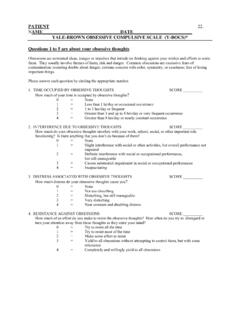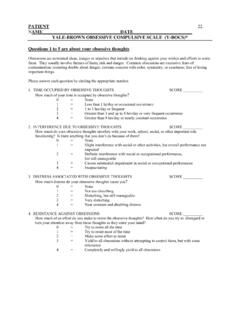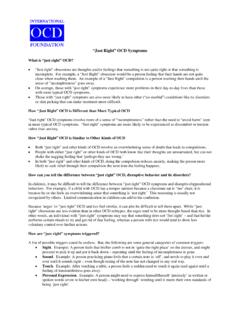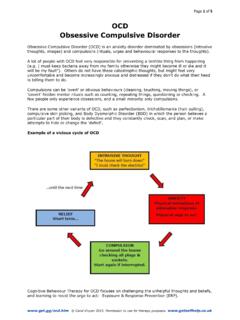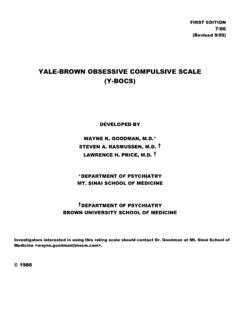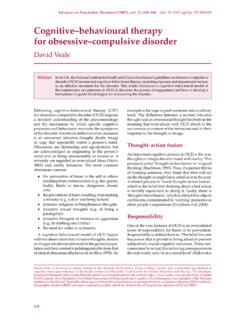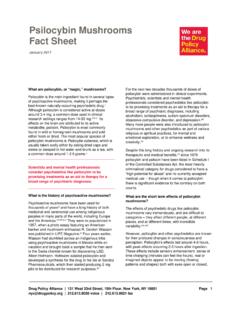Transcription of CHILDREN'S YALE-BROWN OBSESSIVE COMPULSIVE SCALE …
1 1 Original: 10/1/86 First Revision: 3/1/90 Second Revision: 5/1/91 Third Revision: 5/1/93 Fourth Revision: 6/17/99 Fifth Revision: 10/04/07 CHILDREN'S YALE-BROWN OBSESSIVE COMPULSIVE SCALE (CY-BOCS) DEVELOPED BY WAYNE K.
2 GOODMAN, LAWRENCE SCAHILL, MSN, PhD2 LAWRENCE H. PRICE, STEVEN A. RASMUSSEN, MARK A. RIDDLE, 4 JUDITH L. RAPOPORT, NATIONAL INSTITUTE OF MENTAL HEALTH1 THE CHILD STUDY CENTER2 yale UNIVERSITY SCHOOL OF MEDICINE DEPARTMENT OF PSYCHIATRY3 brown UNIVERSITY SCHOOL OF MEDICINE CHILD PSYCHIATRY DIVISION4 JOHNS HOPKINS SCHOOL OF MEDICINE and CHILD PSYCHIATRY BRANCH5 NATIONAL INSTITUTE OF MENTAL HEALTH Investigators interested in using this rating SCALE should contact Lawrence Scahill, , , at the yale Child Study Center, Box 207900, New Haven, CT 06520 or Wayne Goodman.
3 At the National Institute of Mental Health, Bethesda, MD. Scahill, L., Riddle, , McSwiggin-Hardin, M., Ort, , King, , Goodman, , Cicchetti, D. & Leckman, (1997). CHILDREN'S YALE-BROWN OBSESSIVE COMPULSIVE SCALE : reliability and validity. J Am Acad Child Adolesc Psychiatry, 36(6):844-852. 2 GENERAL INSTRUCTIONS Overview: This SCALE is designed to rate the severity of OBSESSIVE and COMPULSIVE symptoms in children and adolescents, ages 6 to 17 years. It can be administered by a clinican or trained interviewer in a semi-structured fashion. In general, the ratings depend on the child's and parent's report; however, the final rating is based on the clinical judgement of the interviewer. Rate the characteristics of each item over the prior week up until, and including, the time of the interview. Scores should reflect the average of each item for the entire week, unless otherwise specified.
4 Informants: Information should be obtained by interviewing the parent(s) (or guardian) and the child together. Sometimes, however, it may also be useful to interview the child or parent alone. Interviewing strategy may vary depending on the age and developmental level of the child or adolescent. All information should be combined to estimate the score for each item. Whenever the CY-BOCS is administered more than once to the same child, as in a medication trial, consistent reporting can be ensured by having the same informant(s) present at each rating session. Definitions: Before proceeding with the questions, define "obsessions" and "compulsions" for the child and primary caretaker as follows (sometimes, particularly with younger children, the interviewer may prefer using the terms "worries" and "habits"): "OBSESSIONS: are thoughts, ideas, or pictures that keep coming into your mind even though you do not want them to.
5 They may be unpleasant, silly or embarrassing." "AN EXAMPLE OF AN OBSESSION IS: the repeated thought that germs or dirt are harming you or other people, or that something unpleasant might happen to you or someone in your family or someone special to you. These are thoughts that keep coming back, over and over again." "COMPULSIONS: are things that you feel you have to do although you may know that they do not make sense. Sometimes you may try to stop from doing them but this might not be possible. You might feel worried or angry or frustrated until you have finished what you have to do." "AN EXAMPLE OF A COMPULSION IS: the need to wash your hands over and over again even though they are not really dirty, or the need to count up to a certain number while you do certain things." "Do you have any questions about what these words called obsessions and compulsions mean?
6 " Symptom Specificity and Continuity: In some cases, it may be difficult to delineate obsessions and compulsions from other closely related symptoms such as phobias, anxious worries, depressive ruminations or complex tics. Separate assessment of these symptoms may be necessary. Although potentially difficult, the delineation of obsessions and compulsions from these closely related symptoms is an essential task of the interviewer. (A full discussion of how to make this determination is beyond the scope and purpose of this introduction.) Items marked with an asterix are items where this delineation may be especially troublesome. 3 Once the interviewer has decided whether or not a particular symptom will be included as an obsession or compulsion on the checklist, every effort should be made to maintain consistency in subsequent rating(s). In a treatment study with multiple ratings over time, it may be useful to review the initial Target Symptom Checklist (see below) at the beginning of subsequent ratings (prior severity scores should not be reviewed).
7 Procedure: Symptom Checklist: After reviewing with the child and parent(s) the definitions of obsessions and compulsions, the interview should proceed with a detailed inquiry about the child's symptoms using the Compulsions Checklist and Obsessions Checklist as guides. It may not be necessary to ask about each and every item on the checklist, but each symptom area should be covered to ensure that symptoms are not missed. For most children and adolescents, it is usually easier to begin with compulsions (pages 9 and 10). Target Symptom List: After the Compulsions Checklist is complete, list the four most severe compulsions on the Target Symptom List on page 10. Repeat this process, listing the most severe obsessions, on the Target Symptom List on page 5. Severity Rating: After completing the Checklist and Target Symptom List for compulsions, inquire about the severity items: Time Spent, Distress, Resistance, Interference, and Degree of Control (questions 6 through 10 on pages 11 through 13).
8 There are examples of probe questions for each item. Ratings for these items should reflect interviewer's best estimate from all available information from the past week, with special emphasis on the Target Symptoms. Repeat the above procedure for obsessions (Pages 4 through 8). Finally, inquire about and rate questions 11 through 19 on pages 14 and 18. Scores can be recorded on the scoring sheet on page 19. All ratings should be in whole integers. Scoring: All 19 items are rated, but only items 1-10 are used to determine the total score. The total CY-BOCS score is the sum of items 1-10; the obsession and compulsion subtotals are the sums of items 1-5 and 6-10, respectively. At this time, items 1A and 6A are not being used in the scoring. Items 17 (global severity) and 18 (global improvement) are adapted from the Clinical Global Impression SCALE (Guy, W.)
9 , 1976) to provide measures of overall functional impairment associated with the presence of OBSESSIVE - COMPULSIVE symptoms. 4 Name Date CY-BOCS OBSESSIONS CHECKLIST Check all items that apply (Item marked "*" may or not be OCD phenomena.) Current Past Contamination Obsessions Concern with dirt, germs, certain illnesses ( , AIDS) Concerns or disgust with bodily waste or secretions ( , urine, feces, saliva) Excessive concern with enviromental contaminants ( , asbestos, radiation, toxic waste) Excessive concern with household items ( , cleaners, solvents) Excessive concern about animals/insects Excessively bothered by sticky substances or residues Concerned will get ill because of contaminant Concerned will get others ill by spreading contaminant (aggressive)
10 No concern with consequences of contamination other than how it might feel * Other (Describe) Aggressive Obsessions Fear might harm self Fear might harm others Fear harm will come to self Fear harm will come to others (may be because something child did or did not do) Violent or horrific images Fear of blurting out obscenities or insults Fear of doing something else embarrassing * Fear will act on unwanted impulses ( to stab a family member) Fear will steal things Fear will be responsible for something else terrible happening ( fire, burglary, flood) Other (Describe) Sexual Obsessions [Are you having any sexual thoughts?]

